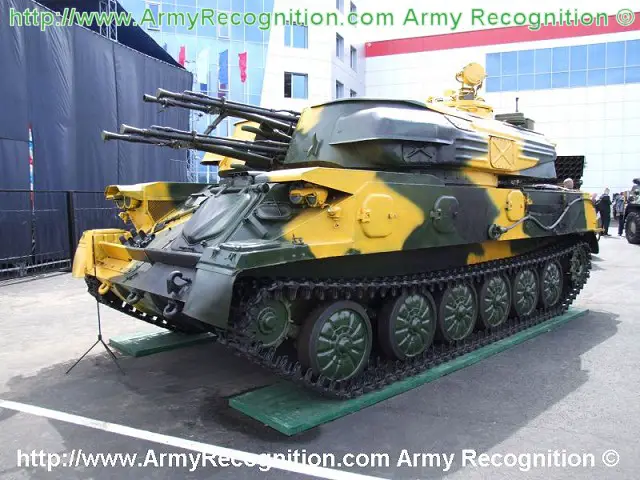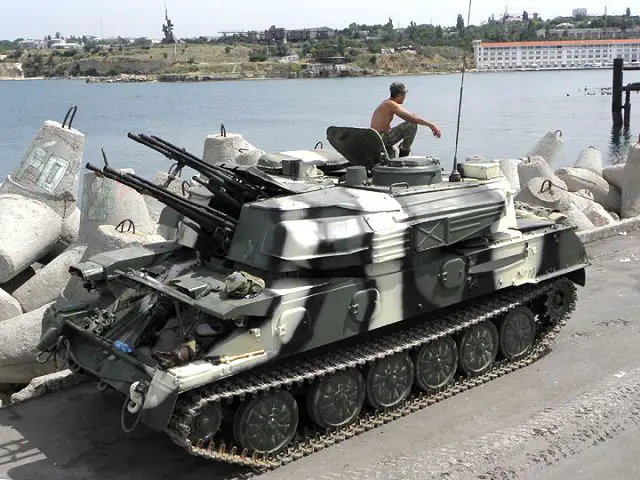- Army
- Conflicts in the world
- Israel - Iran conflict 2025
- Pakistan - India Conflict 2025
- Russia Ukraine War 2022
- Libya conflict day by day
- HAMAS - Israel War 2023
- Operation Serval in Mali French Army
- Sangaris operation Central African Republic
- Sangaris opération militaire République Centreafrique
- Ukraine - Russia conflict
- Syria conflict news
- Defence & Security Industry Technology
- Armies in the world
- Analysis Defense and Security Industry
- Conflicts in the world
- Navy
- Air
Soviet-made ZSU-23-4 Shilka anti-aicraft guns used by Syrian troops against ground threats TASS 10602162
|
|
|||
|
The conflict in Syria
|
|||
|
|
|||
| Soviet-made ZSU-23-4 Shilka anti-aicraft guns used by Syrian troops against ground threats. | |||
|
Syrian President Bashar al-Assad’s forces fighting the Russia-banned Islamic State terrorist group have been using towed and self-propelled antiaircraft guns (SPAAG) against ground threats, with the ZSU-23-4 Shilka SPAAG being especially popular in this role.
|
|||
|
|
|||
 A Syrian Army ZSU-23-4 during the battle of Quseir, June 2013. |
|||
|
|
|||
|
Having entered service with the Soviet Army, the Shilka was exported to all countries operating Soviet-made armament - Afghanistan, Algeria, Angola, Bulgaria, Cuba, Czechoslovakia, the German Democratic Republic, Egypt, Ethiopia, Hungary, India, Iran, Iraq, Jordan, Libya, Mozambique, Nigeria, North Korea, North Yemen, Peru, Poland, Romania, Somali, South Yemen, Syria, Vietnam and Yugoslavia. The ZSU-23-4 got raving reports in the Vietnam War and proved its top-notch effectiveness during the war in the Middle East in 1973.
For the first time in history, the antiaircraft artillery regiments of the Soviet motor-rifle divisions started being used against ground targets during the war in Afghanistan. In particular, the antiaircraft artillery regiment of the 201st Motor-Rifle Division, 40th Army, which was equipped with the S-60 AA gun, would often be used on combat operations, because the 57-mm automatic weapon proved to be very accurate in engaging ground targets and, hence, was used in the fire support role as part of the motor-rifle battalions. The primary targets were the enemy’s weapon emplacements accommodating machineguns, including Degtyaryov Shpagin DShK ones. Often, they would be set up in caves on ridgelines or in wattle and daub huts. A two-platoon AA battery would usually operate platoon-wise. At times, individual guns would be attached to supported units, which commanders would task the attached gunners and provide target designation. |
|||
|
|
|||
 The Soviet-made ZSU-23-4 is self-propelled anti-aircraft guns armed with with four AZP-23 23 mm canons with an elevation of +85° to - 4°, and 360° turret traverse. The Soviet-made ZSU-23-4 is self-propelled anti-aircraft guns armed with with four AZP-23 23 mm canons with an elevation of +85° to - 4°, and 360° turret traverse. |
|||
|
|
|||
|
The ZSU-23-4 Shilka was used in Afghanistan against ground threats on a large scale too. SPAAG elements, mostly ZSU-23-4 platoons providing air defense coverage on the march when required would be tasked with eliminating enemy weapon emplacements and lightly armored vehicles, i.e. the targets that could not be destroyed by artillery with the minimal ammunition expenditure. The high accuracy, rate of fire, elevation angles and reliability, short reaction time, sufficient projectile lethality and ability to fire on the move were the basic considerations nudging infantry commanders to have SPAAGs attached to their units on operations.
The ZSU-23-4 was upgraded to enable it to accurately engage moving targets at night. The upgraded ZSU-23-4M2 version was stripped of its radar in favor of a large ammunition load (3,000 rounds over 2,000 rounds previously) and was equipped with the TPNZ-49 tank night scope and PSNR-5 man-portable ground surveillance radar. The upgraded variant proved to be very effective on the battlefield. The ZSU-23-4’s ammunition load comprises the 23-mm BZT armor-piercing/incendiary/tracer and OFZT blast-fragmentation/incendiary/tracer projectiles. The 190-g BZT has no fuse and explosive filling - only an incendiary compound for the tracer effect. The 188.5-g OFZT has the MG-25 impact fuse. Both have the same propellant charge - 77 g of the 5/7 TsFL powder. The round of ammunition weighs 450 g and has a disposable steel casing. The ballistic characteristics of both projectiles are the same - a muzzle velocity of 980 m/s, a table altitude of 1,500 m and a table range of 2,000 m. The ZSU-23-4 is a belt-fed weapon using 50-round ammo belts filled with a BZT round after every four OFZT ones. The lessons learnt have been widely used in recent armed conflicts as well. Suffice it to recollect the Libyan War, in which ZU-23s and ZPU-2s would be mounted on high-mobility pickups and used as mobile firepower. Makeshift SP guns like these would engage ground targets only and be very effective. |
|||
|
|
|||
 Russian ZSU-23-4M2, so-called "Afghan" variant. Reequipment performed during the Soviet–Afghan War for mountain combat. The radar system was removed and a night-sight was added. Ammunition increased from 2,000 to 4,000 rounds Russian ZSU-23-4M2, so-called "Afghan" variant. Reequipment performed during the Soviet–Afghan War for mountain combat. The radar system was removed and a night-sight was added. Ammunition increased from 2,000 to 4,000 rounds |
|||
|
|
|||
| © Copyright 2016 TASS. All rights reserved. This material may not be published, broadcast, rewritten or redistributed. | |||


























